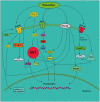Progress in the Understanding of the Mechanism of Tamoxifen Resistance in Breast Cancer
- PMID: 33362547
- PMCID: PMC7758911
- DOI: 10.3389/fphar.2020.592912
Progress in the Understanding of the Mechanism of Tamoxifen Resistance in Breast Cancer
Abstract
Tamoxifen is a drug commonly used in the treatment of breast cancer, especially for postmenopausal patients. However, its efficacy is limited by the development of drug resistance. Downregulation of estrogen receptor alpha (ERα) is an important mechanism of tamoxifen resistance. In recent years, with progress in research into the protective autophagy of drug-resistant cells and cell cycle regulators, major breakthroughs have been made in research on tamoxifen resistance. For a better understanding of the mechanism of tamoxifen resistance, protective autophagy, cell cycle regulators, and some transcription factors and enzymes regulating the expression of the estrogen receptor are summarized in this review. In addition, recent progress in reducing resistance to tamoxifen is reviewed. Finally, we discuss the possible research directions into tamoxifen resistance in the future to provide assistance for the clinical treatment of breast cancer.
Keywords: autophagy; breast cancer; cell cycle regulators; resistance; tamoxifen.
Copyright © 2020 Yao, Deng, Huang, Zeng and Zuo.
Conflict of interest statement
The authors declare that the research was conducted in the absence of any commercial or financial relationships that could be construed as a potential conflict of interest.
Figures

References
-
- Block M., Gründker C., Fister S., Kubin J., Wilkens L., Mueller M. D., et al. (2012). Inhibition of the AKT/mTOR and erbB pathways by gefitinib, perifosine and analogs of gonadotropin-releasing hormone I and II to overcome tamoxifen resistance in breast cancer cells. Int. J. Oncol. 41 (5), 1845–1854. 10.3892/ijo.2012.1591. - DOI - PubMed
Publication types
LinkOut - more resources
Full Text Sources
Other Literature Sources

